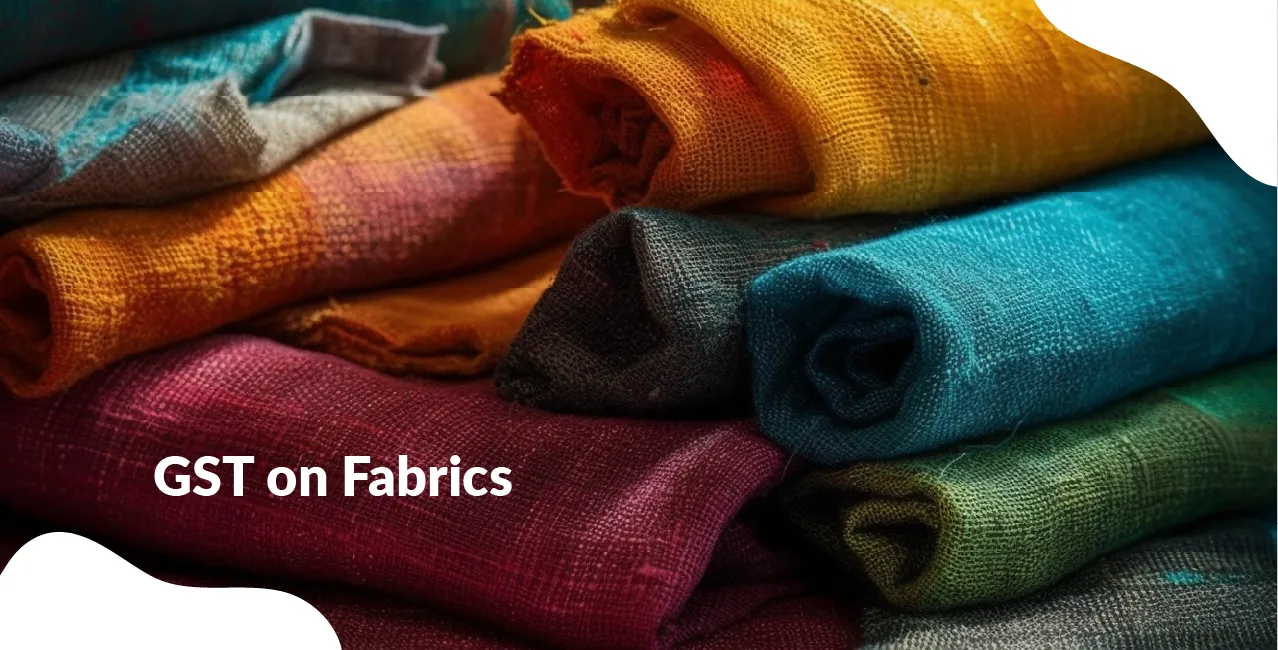
Author
LoansJagat Team
Read Time
5 Min
02 Jul 2025
GST on Fabrics – Rates, HSN Codes & Textile Sector Impact
Goods and Services Tax (GST) on fabrics in India is generally 5%. This rate applies to most fabrics, making them more affordable while ensuring tax compliance across the textile industry.
Example:
A fabric shop buys cotton fabric worth ₹10,000 from a manufacturer. The manufacturer charges 5% GST, so the shop pays ₹10,500. When the shop sells the fabric for ₹12,000, it collects 5% GST (₹600) from the customer. The shop can then claim input tax credit of ₹500 already paid and only needs to pay ₹100 to the government.
This system helps avoid tax-on-tax (cascading effect) and brings transparency to fabric pricing.
Read More - GST on Clothes – Updated Rates & Complete Guide
GST on Various Categories of Fabrics
The GST rates on fabrics vary based on their type, use, and manufacturing process. While everyday clothing fabrics attract lower tax, specialised or industrial fabrics are taxed at higher rates. The table below shows the common fabric categories and their GST rates.
HSN Codes for Fabrics
The Harmonised System of Nomenclature (HSN) helps classify goods under GST for uniform taxation. Each fabric type has a specific HSN code, which is used for invoicing and filing GST returns. The table below lists common fabric types with their HSN codes.
Note:
- The HSN codes are used by businesses to classify goods under GST for proper tax calculation.
- Codes may vary slightly depending on the fabric composition and weave, so it’s always good to check the full GST schedule for exact classification if needed.
Impact of GST on the Fabrics Industry
GST (Goods and Services Tax) made tax rules the same across India. Before GST, each state had its own tax system, which caused confusion and price differences. Now, most fabrics are taxed at 5%, which makes trade easier and more organised.
Also Read - Clothing Business Ideas: Trendy and Profitable Ventures for 2025
However, small weavers and cloth traders who didn’t pay tax earlier now have to pay 5%, which increased their costs.
For example, there's a man named Raju. He sells cotton cloth in a shop in Surat. Before GST started, Raju didn't have to pay any tax when he sold clothes. So, if he sold cloth for ₹1,00,000, he kept all the money (except his usual costs).
But now, because of GST, the government says,
“Raju, you must pay 5% tax on what you sell.”
So now, if he sells the same cloth for ₹1,00,000, he has to pay ₹5,000 as GST to the government.
That means Raju has to do more paperwork, and he earns a little less because he must give some money as tax.
But why is this done?
Because the government wants to make sure everyone pays tax equally, no matter where they live. It helps the country stay fair and organised.
So Raju Uncle is learning to use a computer, make bills, and file his taxes. It's harder at first, but it helps make his business grow bigger in the long run!
Input Tax Credit (ITC) on Fabrics
Input Tax Credit (ITC) means you can claim back the GST you already paid on items used to make or sell another product.
Example: A shirt maker buys fabric, pays GST, and later sells the final product. He uses ITC to reduce his tax payment.
He pays only ₹50 more as GST, because he already paid ₹50 earlier. This earlier payment becomes his input tax credit.
Why is ITC useful?
- It reduces double taxation.
- Helps keep costs lower.
- Encourages businesses to keep proper bills and stay registered under GST.
Conclusion of GST on Fabrics
The introduction of GST has changed the way the fabric industry works. It brought one single tax across all states, which helped make the fabric trade more transparent and organised. Most fabrics now have a 5% GST, which is easy to apply and understand.
Big manufacturers benefit from this system because they can claim input tax credit, which reduces their final tax payment. They also have better records and smoother business across the country.
FAQ’s
1. What is the GST rate on fabrics?
Most fabrics attract a flat GST rate of 5% in India.
2. Do stitched garments have the same GST as fabrics?
No, stitched garments usually have higher GST rates, often 12% or 18%.
3. Can small fabric sellers avoid paying GST?
If their turnover is below ₹20,00,000, they may be exempt from GST registration.
4. What is Input Tax Credit (ITC) in fabrics?
ITC lets businesses claim back GST paid on fabric used to make finished goods.
5. Are all fabrics taxed equally under GST?
No, most are 5%, but eco-friendly jute fabric is exempt from GST.
Other Important GST Pages | ||||
About the Author

LoansJagat Team
‘Simplify Finance for Everyone.’ This is the common goal of our team, as we try to explain any topic with relatable examples. From personal to business finance, managing EMIs to becoming debt-free, we do extensive research on each and every parameter, so you don’t have to. Scroll up and have a look at what 15+ years of experience in the BFSI sector looks like.

Quick Apply Loan
Subscribe Now


